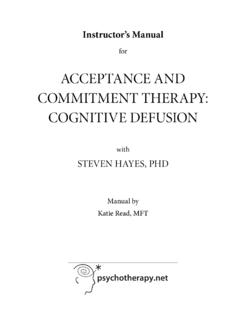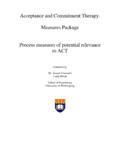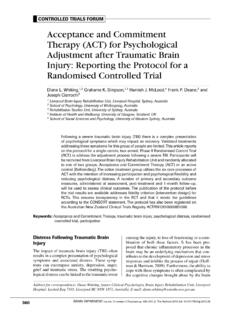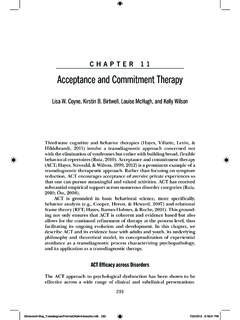Transcription of ACCEPTANCE AND COMMITMENT THERAPY: …
1 Instructor s ManualforACCEPTANCE AND COMMITMENT therapy : psychological flexibility withSTEVEN HAYES, PHDM anual byKatie Read, MFT2 ACCEPTANCE AND COMMITMENT therapy : psychological flexibility WITH STEVEN HAYES, PHD! e Instructor s Manual accompanies the DVD ACCEPTANCE and COMMITMENT ! erapy: psychological flexibility with Steven Hayes, PhD (Institutional/Instructor s Version). Video available at 2013, , LLC. All rights reserved. Published by Shoreline Highway, Building A, Suite 1 Mill Valley, CA 94941 Email: (800) 577-4762 (US & Canada)/(415) 332-3232 Teaching and Training: Instructors, training directors and facilitators using the Instructor s Manual for the video ACCEPTANCE and COMMITMENT ! erapy: psychological flexibility with Steven Hayes, PhD may reproduce parts of this manual in paper form for teaching and training purposes only.
2 Otherwise, the text of this publication may not be reproduced, stored in a retrieval system, or transmitted in any form or by any means electronic, mechanical, photocopying, recording or otherwise without the prior written permission of the publisher, ! e video ACCEPTANCE and COMMITMENT ! erapy: psychological flexibility with Steven Hayes, PhD (Institutional/Instructor s Version) is licensed for group training and teaching purposes. Broadcasting or transmission of this video via satellite, Internet, video conferencing, streaming, distance learning courses or other means is prohibited without the prior written permission of the , Katie MFTA cceptance and COMMITMENT ! erapy: psychological flexibility with Steven Hayes, PhDCover design by Julie GilesCover painting by Victor YalomOrder Information and Continuing Education Credits:For information on ordering and obtaining continuing education credits for this and other psychotherapy training videos, please visit us or call s Manual forACCEPTA NCE A ND COM MITM ENT therapy .
3 psychological flexibility WITH STEVEN HAYES, PHDT able of ContentsTips for Making the Best Use of the DVD 4 Summary of Approach 6 Discussion Questions 12 Role-Plays 14 Reaction Paper Guide for Classrooms and Training 16 Related Websites, Videos and Further Readings 17 Tra nscript 19 Video Credits 66 Earn Continuing Education Credits for Watching Videos 67 About the Contributors 68 More Videos 694 ACCEPTANCE AND COMMITMENT therapy : psychological flexibility WITH STEVEN HAYES, PHDTips for Making the Best Use of the DVD1. USE THE TRANSCRIPTS Make notes in the video Tra nscript for future reference; the next time you show the video you will have them available. Highlight or notate key moments in the video to better facilitate discussion during and a" er the FACILITATE DISCUSSION Pause the video at di# erent points to elicit viewers observations and reactions to the concepts presented.
4 ! e Discussion Questions section provides ideas about key points that can stimulate rich discussions and learning. 3. ENCOURAGE SHARING OF OPINIONSE ncourage viewers to voice their opinions. What are viewers impressions of what is presented in the interview? 4. CONDUCT A ROLE-PLAY! e Role-Play section guides you through exercises you can assign to your students in the classroom or training HAVE STUDENTS OR TRAINEES WATCH OTHER TITLES IN THIS SERIES WITH SAME CLIENT! is video is part of a six-video series, ACCEPTANCE and COMMITMENT ! erapy with Steven Hayes, PhD. Watch the other videos in the series to give students the complete clinical picture of ACCEPTANCE and COMMITMENT ! erapy, demonstrated by a wide variety of clinicians and SUGGEST READINGS TO ENRICH VIDEO MATERIALA ssign readings from Related Websites, Videos and Further Reading prior to or a" er ASSIGN A REACTION PAPERSee suggestions in the Reaction Paper ON VIDEOS AND THE PERSONALITY OF THE THERAPISTP sychotherapy portrayed in videos is less o# -the-cu# than therapy in practice.
5 ! erapists may feel put on the spot to o# er a good demonstration, and o" en move more quickly than they would in everyday practice to demonstrate a particular technique. Despite these factors, therapists and clients on video can engage in a realistic session that conveys a wealth of information not contained in books or therapy transcripts: body language, tone of voice, facial expression, rhythm of the interaction, quality of the alliance all aspects of the therapeutic relationship that are unique to an interpersonal encounter. Psychotherapy is an intensely private matter. Unlike the training in other professions, students and practitioners rarely have an opportunity to see their mentors at work. But watching therapy on video is the next best more note: ! e personal style of therapists is o" en as important as their techniques and theories.
6 ! erapists are usually drawn to approaches that mesh well with their own personality. ! us, while we can certainly pick up ideas from master therapists, students and trainees must make the best use of relevant theory, technique and research that $ ts their own personal style and the needs of their AND COMMITMENT therapy : psychological flexibility WITH STEVEN HAYES, PHDA cceptance and COMMITMENT ! erapy: A Summary of ApproachAcceptance and COMMITMENT ! erapy or ACT (pronounced as a word, not as separate initials) was developed in the late 1980s by Steven Hayes, Kelly Wilson, and Kirk Strosahl, and is considered part of the third wave of behavioral therapies along with Dialectical Behavior ! erapy (DBT), Mindfulness-Based Cognitive ! erapy (MBCT) and Mindfulness-Based Stress Reduction (MBSR) all of which place a major emphasis on the development of mindfulness skills.
7 It is an empirically-based therapy using ACCEPTANCE and mindfulness strategies along with COMMITMENT and behavior-change strategies to increase psychological % is based on relational frame theory (RFT), a comprehensive theory of language and cognition that is an o# shoot of behavior analysis. ACT di# ers from traditional cognitive behavioral therapy (CBT) in that rather than trying to teach people to better control their thoughts, feelings, sensations, memories, and other private events, ACT teaches them to notice and accept them even previously unwanted ones. ACT helps the individual get in contact with a transcendent sense of self known as self-as-context the self that is always there observing and experiencing but is separate from one s thoughts, feelings, sensations, and memories.
8 ACT aims to help the people clarify their personal values and take action on them, bringing more vitality and meaning to life and increasing psychological % exibility. Western psychology has typically operated under the healthy normality assumption, which states that by their nature, humans are psychologically healthy. ACT assumes, rather, that the psychological processes of a normal human mind are o" en destructive. ! e core conception of ACT is that psychological su# ering is usually caused by experiential avoidance, cognitive entanglement, and resulting psychological rigidity. ! ese lead to a failure to take needed behavioral steps in accord with core values. As a simple way to summarize the model, ACT views the core of many problems to be due to the concepts represented in the acronym, Fusion with your thoughts Evaluation (o" en negative) of experience Avoidance of your experience Reason-giving for your behaviorAnd the healthy alternative is to ACT: Accept your reactions and be present Choose a valued direction Take actionCore Processes and Treatment!
9 E root goal of ACT is a change in one s internal self-talk and one s external behavior. ACT teaches clients to observe themselves having feelings and then accept those feelings, as $ ghting or avoiding emotions worsens their e# ect. ACT then focuses on a shi" from the content of an experience to the context of an experience. ACT distinguishes between ACCEPTANCE of things that cannot be changed like our history and those that can, such as leaving an abusive relationship.! ere are six core processes of ACT: 1. Cognitive defusion: Learning to not be so controlled by one s own thoughts, but rather to recognize thoughts without getting caught up in their ACCEPTANCE : Allowing one s thoughts and feelings to come and go without struggle and accepting the reality of one s Contact with the present moment: Mindful awareness of the present on a moment-to-moment Self-as-context (observing self): Learning to access a continuity of consciousness that is unchanging the observing mind or observing self.
10 5. Va lue s: De$ ning what is most important to a Committed action: Setting goals based on values and committing to them, despite contrary thoughts or emotions that might arise. 8 ACCEPTANCE AND COMMITMENT therapy : psychological flexibility WITH STEVEN HAYES, PHDA basic ACT treatment using the six processes above might look as follows:1. Examine avoidant behaviors. Clients have o" en struggled at great length with their problems and frequently enter treatment with a goal of eliminating painful thoughts or emotions. Avoidant behaviors are usually examined $ rst. For example, what does the client do currently to avoid negative thoughts or feelings, or to escape them when they arise? 2. Examine strategies that have not worked. In struggling with and focusing on the presenting problem, clients o" en make the problem appear even worse.















